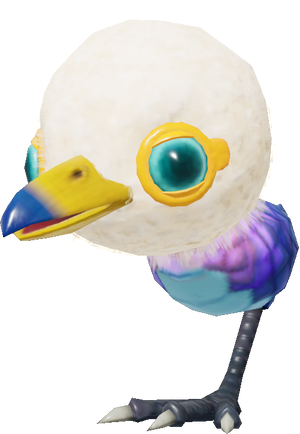Downy Snagret
| |||
|---|---|---|---|

| |||
| Appears in | Pikmin 4 | ||
| Scientific name | Shiropedes anacondii (fledgling) | ||
| Family | Snavian | ||
| Areas | Blossoming Arcadia, Blossoming Arcadia (Olimar's Shipwreck Tale) | ||
| Caves | Drafty Gallery, Plunder Palace | ||
| Dandori Challenge stages | Ice-Cross Course | ||
| Dandori Battle stages | Hot Sandy Duel | ||
| Attacks | Eat Pikmin | ||
The Downy Snagret (ヒナガラス?, lit.: "Fledgling Crow") is an enemy in Pikmin 4. It is a juvenile version of the Burrowing Snagret which is closely resembles. Unlike its adult counterpart, it does not burrow. Instead it hops around on its singular foot and pecks up Pikmin. They are often found near Burrowing Snagrets or inside nectar eggs.
Stats
| Weight | Max. carriers |
Seeds | Value | Health |
|---|---|---|---|---|
| 3 | 6 | 3 | 300 |
Behavior
|
The following article or section is in need of assistance from someone who plays Pikmin 4. |
The Downy Snagret can usually be found hopping around in a small area; however, it can sometimes be within an egg instead. Upon noticing the player and their Pikmin, it hops towards them and tries to eat them. If it successfully grabs a Pikmin, it takes about a second to slide it down its mouth and swallow it.
Appearance
It closely resembles the Burrowing Snagret. It has a round, white head with a slim blue body and a single leg with three clawed toes. Unlike the adult, it does not lose its feathers as it takes damage.
Locations
Strategy
To limit the amount of casualties had, it is best to continuously throw Pikmin onto it until it dies. With a high enough level Oatchi Rush, particularly once Rush Lv. 3 has been learned, he is able to kill it with a single Rush attack.
Notes
Dalmo's Notes
Olimar's Notes
However, the Downy Snagret has two specific conditions for imprinting. The first is that the target must be tall and blue, and the second is related to the sound of its cry. This means that it will never make a mistake with something as small as we are and will instead recognize it...or us...as food.
Since it is still a fledgling, the Downy Snagret does not go underground to feed. Instead, it stays on the surface where there is plenty of food. It looks harmless enough, but beware... Its parent may be hiding nearby until the baby is old enough to fend for itself.”
Louie's Notes
Pikmin Garden
Text
“ヘビガラスのひな鳥。頭部はふわふわな幼綿羽に覆われていて、これが生え変わるまでは地中には潜らず、餌の豊富な地上で活動する。
特徴 その1 地上で活動する
- 地上に産み落とされた卵から生まれる。
- (Image text:
- 羽毛がないヘビガラスは、地熱や日光などで卵を温める
- 一本足ではねまわり、くちばしで獲物をついばむ)
特徴 その2 刷り込み
- ふ化後すぐに見た動くものや、声を発するものを親と認識する。
- (Image text: 刷り込みには、青く背が高いことと甲高い鳴き声が必要)
特徴 その3 尾羽
- お尻の先のとがった鱗をめくると、白く短い尾羽が生えている。
- (Image text: 白い無地の尾羽がヘビガラスの特徴(近縁種のヘビがモメには斑紋がある))”
Translation
“A Burrowing Snagret fledgling. Its head is covered with fluffy downy feathers, and it stays on the surface where there is plenty of food, rather than going underground, until it grows out of its feathers.
Feature #1: Active above ground
- It is born from eggs laid above the ground.
- (Image text:
- "The Burrowing Snagret, lacking feathers, warms its eggs with heat from the ground or sunlight"
- "It jumps around on one leg and pecks at its prey with its beak")
Feature #2: Imprinting
- Immediately after hatching, they recognize moving or vocalizing objects as their parents.
- (Image text: "Imprinting requires a tall, blue body and a high-pitched cry")
Feature #3: Tail feathers
- When the spiky scales at the tip of its rear are removed, short white tail feathers grow out.
- (Image text: "Plain white tail feathers are characteristic of the Burrowing Snagret (those of the closely related Burrowing Snarrow have spots)")”
Other information
- Pikmin 4 Piklopedia number: #68
Naming
- See more: Snavian family#Naming.
- Common name: Downy Snagret. Downy means "covered with fine soft hair or feathers". It could also be from the downy woodpecker.
- Japanese nickname: ヒナガラス?, lit.: "Fledgling Crow".
- Japanese name: オジロヘビガラス ひな鳥?, lit.: "White-tailed Snake Crow (fledgling)". "オジロへビガラス" is the Japanese name for the Burrowing Snagret, with the added specification that it is in its fledgling state.
- Scientific name: Shiropedes anacondii (fledgling). Shiropedes anacondii is the scientific name for the Burrowing Snagret, with the added specification that it is in its fledgling state.
- Internal names:
BABYCROW. The Burrowing Snagret's internal name isSNAKECROW, so it is clarified that this state is when its a baby. - Prerelease: None.
Names in other languages
| Language | Name | Meaning | Notes |
|---|---|---|---|
| ヒナガラス? Hina-Garasu |
Fledgling Crow | ||
(traditional) |
雛生蛇鱗鴉 Chú Shēng Shé Lín Yā |
Newly Hatched Snake Scale Crow | |
(simplified) |
雏生蛇鳞鸦 Chú Shēng Shé Lín Yā |
Newly Hatched Snake Scale Crow | |
| Sleigerkuiken | Sleiger chick | "Sleiger" is a portmanteau of "slang" (snake) and "reiger" (heron) | |
| Snabrek duveteux | Downy snagret | ||
| Schnapper-Küken | Snatcher Chick | ||
| Vermentilla pulcino | Chick vermentilla | "Vermentilla" comes from "verme" (worm) and possibly "serpente" (snake) | |
| 까마귀병아리 Kkamagwi-Byeongari |
Crow Chick | ||
| Corvurinho | Little anacrowda | "Corvuri" is a portmanteau of "corvo" (crow) and "sucuri" (anaconda), while "-inho" is a diminutive suffix | |
| Tagarote pichón | Squab snagret |
Gallery
|
This article or section is in need of more images. Particularly: |
A Downy Snagret eating pikpik carrots.
A Downy Snagret popping out of a broken egg in the Piklopedia.
A Downy Snagret in the Drafty Gallery.





